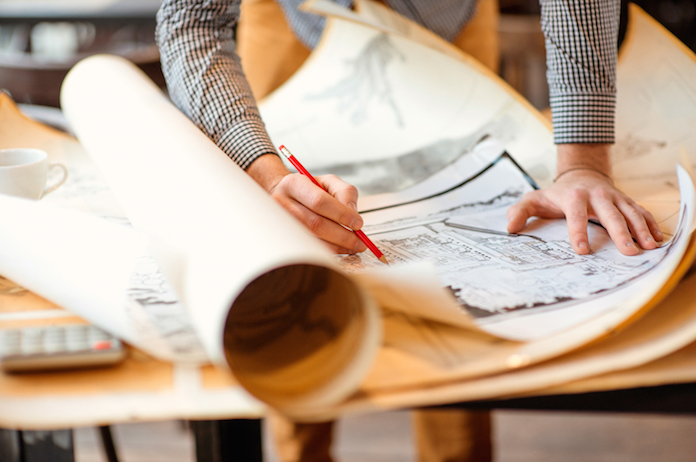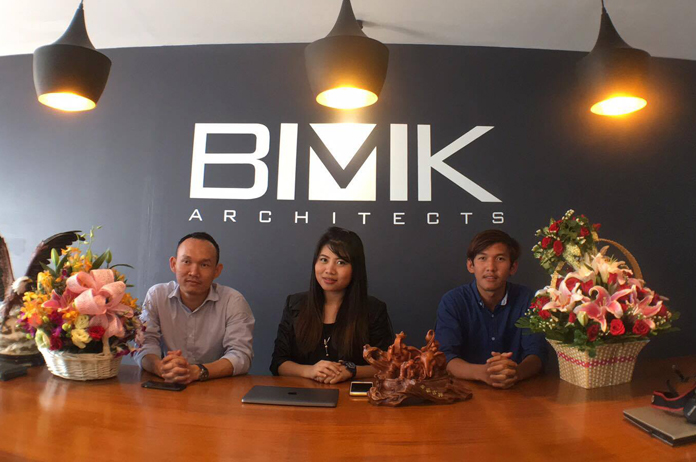Betting On Sustainability: Young Architects Carve Out Their Own Niche
By B2B Cambodia
on
 The indirect benefits of sustainable architecture and design are not always on the minds of clients but promoting green or sustainable initiatives can help architects and designers differentiate themselves in a price-competitive construction sector and attract Cambodian clients with more money to spend, architects and designers tell B2B.
Carving out a niche
Muygech Sok is focused on renovating and adding value to city shophouses. The 25-year-old director of BMK Architects says that they are the most desirable of all property investments for urban Cambodians who often wish to run a business on the ground floor and who prefer the certainty of land ownership that shophouses provide. Many of them will need to be renovated in the next 10 years, she says.
Sok offers clients sustainable but cost-effective solutions aimed at improving people’s quality of life. “I try to propose the installation of a skylight in the middle of the building that allows for natural ventilation and access to natural light. Many clients complain that shophouses are stuffy, that there is not enough fresh air, and that they never see sunlight—and that is what we try to fix.”
The indirect benefits of sustainable architecture and design are not always on the minds of clients but promoting green or sustainable initiatives can help architects and designers differentiate themselves in a price-competitive construction sector and attract Cambodian clients with more money to spend, architects and designers tell B2B.
Carving out a niche
Muygech Sok is focused on renovating and adding value to city shophouses. The 25-year-old director of BMK Architects says that they are the most desirable of all property investments for urban Cambodians who often wish to run a business on the ground floor and who prefer the certainty of land ownership that shophouses provide. Many of them will need to be renovated in the next 10 years, she says.
Sok offers clients sustainable but cost-effective solutions aimed at improving people’s quality of life. “I try to propose the installation of a skylight in the middle of the building that allows for natural ventilation and access to natural light. Many clients complain that shophouses are stuffy, that there is not enough fresh air, and that they never see sunlight—and that is what we try to fix.”
 BMK's Director Muygech Sok with associates
Despite clients recognizing the design flaws inherent in their purchases, she says it is hard work trying to change the reining mindset, which does not place any value on design at all. “Land is very expensive. It is very hard for people to give over space for a central courtyard and ventilation when they have spent $1 million on buying the property,” she says. “What we can try to do is to convince them that this technique will improve their quality of life as well as cut down their electricity bill and the temperature in the building.”
With 13 projects in hand after only five months in business, the architect and university lecturer is determined to make a success of it her own way, like her mentor and former lecturer Hun Chansan, design director of progressive firm Re-edge Architecture and Design.
It is a fun time to be an architect or designer, says Hun Chansan. “We had the luxury of starting first and carving out a certain niche to be working in. If they see that is a success then I think that is good for them.”
Chansan says he operates in a market that is not affected by the big property developments that have some investors so worried. “Younger architects should not be worried about not getting projects with the big guys. The local people will survive. They will keep on doing things,” he says.
He agrees that arguing for the holistic benefits of sustainable design—including aesthetics—is more effective than trying to argue for sustainability on price when dealing with clients. “The most important thing is human comfort. It is the experience of people living inside a space,” he says.
Social spaces
Nath Kanada and Seyrith Sarm of The Grey Studio aim to improve the quality of social spaces just like their immediate forebears Hok Kang Architects, the firm behind Brown Coffee. “Before Brown, there was not really anywhere for us to hang out,” Kanada says.
Beer gardens were for older men. Instead the young students played football in the abandoned plots now so desirable on the property market until they were chased away by the their owners. “Mister Kang Hok said that he wanted to have a place for young people to hang out and go to, a place for them to work on a project or assignment. He achieved that. That architecture can make this happen—this is what drives the new generation to continue with their careers.”
True to calling, in the last three years the Grey Studio has focused on decking out trendy interiors demanded by the new wave of fashionable cafes, bar, and hotels that followed Brown and are transforming Phnom Penh.
Sustainable practices and eco-facades are popular with some businesses targeting the higher end of the market. They usually have practical application, too, although it is easier to sell sustainable initiatives on aesthetic grounds, Kanada says, much like his Vietnamese hero Vo Trong Nghia.
BMK's Director Muygech Sok with associates
Despite clients recognizing the design flaws inherent in their purchases, she says it is hard work trying to change the reining mindset, which does not place any value on design at all. “Land is very expensive. It is very hard for people to give over space for a central courtyard and ventilation when they have spent $1 million on buying the property,” she says. “What we can try to do is to convince them that this technique will improve their quality of life as well as cut down their electricity bill and the temperature in the building.”
With 13 projects in hand after only five months in business, the architect and university lecturer is determined to make a success of it her own way, like her mentor and former lecturer Hun Chansan, design director of progressive firm Re-edge Architecture and Design.
It is a fun time to be an architect or designer, says Hun Chansan. “We had the luxury of starting first and carving out a certain niche to be working in. If they see that is a success then I think that is good for them.”
Chansan says he operates in a market that is not affected by the big property developments that have some investors so worried. “Younger architects should not be worried about not getting projects with the big guys. The local people will survive. They will keep on doing things,” he says.
He agrees that arguing for the holistic benefits of sustainable design—including aesthetics—is more effective than trying to argue for sustainability on price when dealing with clients. “The most important thing is human comfort. It is the experience of people living inside a space,” he says.
Social spaces
Nath Kanada and Seyrith Sarm of The Grey Studio aim to improve the quality of social spaces just like their immediate forebears Hok Kang Architects, the firm behind Brown Coffee. “Before Brown, there was not really anywhere for us to hang out,” Kanada says.
Beer gardens were for older men. Instead the young students played football in the abandoned plots now so desirable on the property market until they were chased away by the their owners. “Mister Kang Hok said that he wanted to have a place for young people to hang out and go to, a place for them to work on a project or assignment. He achieved that. That architecture can make this happen—this is what drives the new generation to continue with their careers.”
True to calling, in the last three years the Grey Studio has focused on decking out trendy interiors demanded by the new wave of fashionable cafes, bar, and hotels that followed Brown and are transforming Phnom Penh.
Sustainable practices and eco-facades are popular with some businesses targeting the higher end of the market. They usually have practical application, too, although it is easier to sell sustainable initiatives on aesthetic grounds, Kanada says, much like his Vietnamese hero Vo Trong Nghia.
 The Grey Studio's Nath Kanada (left) and Seyrith Sarm aim to improve the capital's social spaces.
Hok Kang’s Chanritty San says that pushing green ideas on clients is not easy. “Even for Vo Trong Nghia, it is not easy,” he says. Cultural factors could be played to. “We have trees on almost all of our products. But that’s easy. People here they don’t like tanned skin. Trees also drop the temperature by three or four degrees, and that’s quite significant. They also help absorb carbon emissions. But that is the bigger picture and it is there if you want to see it but if you don’t want to see it is not there. First and foremost for clients is how a solution will help their development in terms of public image, reputation, and attract a certain group of clientele who might also be advocates of green ideas.”
The Grey Studio's Nath Kanada (left) and Seyrith Sarm aim to improve the capital's social spaces.
Hok Kang’s Chanritty San says that pushing green ideas on clients is not easy. “Even for Vo Trong Nghia, it is not easy,” he says. Cultural factors could be played to. “We have trees on almost all of our products. But that’s easy. People here they don’t like tanned skin. Trees also drop the temperature by three or four degrees, and that’s quite significant. They also help absorb carbon emissions. But that is the bigger picture and it is there if you want to see it but if you don’t want to see it is not there. First and foremost for clients is how a solution will help their development in terms of public image, reputation, and attract a certain group of clientele who might also be advocates of green ideas.”